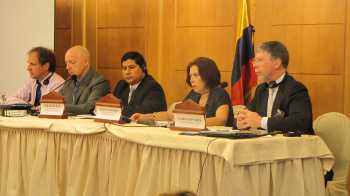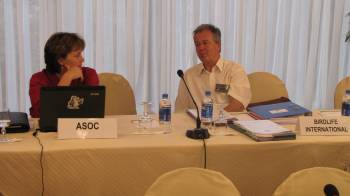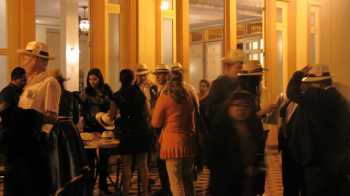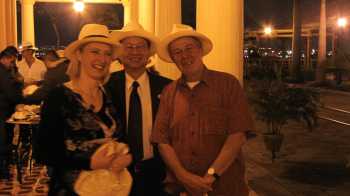The Sixth Meeting of the Advisory Committee of the Agreement on Albatrosses and Petrels commenced its deliberations in the Unipark Hotel, Guayaquil, Ecuador yesterday, with delegations of 12 of the 13 Parties present. Discussions will continue until Friday 2nd September.
The meeting commenced with welcoming addresses by Maria Elena Porros, Coordinadora General de Derechos y Garantias and Nelson Zambrano López, Director de Gestión y Coordinación Marina y Costera, Ministerio de Ambiente de Ecuador. In their remarks they made mention of the world-famous Galapagos Islands, home to many seabird species, including the ACAP-listed and Ecuadorian endemic Waved Albatross Phoebastria irrorata, as well as Isla de la Plata off Ecuador's mainland, the only other breeding site of this Critically Endangered albatross.

Mark Tasker, Advisory Committee Vice-Chair, Marco Favero, Chair,
Nelson Zambrano, Ecuador Ministry of Environment and Warren Papworth
listen to Maria Elena Porros address the opening session
Warren Papworth, ACAP Executive Secretary and Marco Favero, Chair ACAP Advisory Committee replied, thanking the Ecuadorian hosts for their hospitality and drawing attention to the work of the Agreement in 2007 in developing an action plan for the Waved Albatross, for which a round-table to discuss implementing and reviewing the plan had been held over the preceding weekend. Marco Favero then opened the meeting, informing attendees of the full agenda that needed to be addressed.
In the first day deliberations considered various procedural and financial matters as well reports from NGO observers in attendance, including ASOC (Antarctic and Southern Ocean Coalition), BirdLife International, Humane Society International and WWF. All expressed their appreciation for the close collaborations that continued to take place between their organizations and ACAP, especially in relation to seabird bycatch, often conducted for and at meetings of tuna regional fishery management organizations. This view was reciprocated by the meeting's Chair.

NGO corner: Estelle van der Merwe of ASOC and
John Croxall of BirdLife International confer at the opening session
The observer from the Convention on Migratory Species, its Scientific and Technical Officer, Borja Heredia, informed the meeting of a survey the CMS was undertaking to assess the non-target impacts of gill-netting on migratory marine fauna, including on seabirds. The report was expected to be submitted to the 10th Session of the Conference of Parties to the CMS, to be held in Bergen, Norway in November this year. Last week ACAP's Seabird Bycatch Working Group had discussed the effects of gill-netting on ACAP-listed species, so news of the impending CMS report was welcomed by the group's Convenor, Barry Baker. The Ecuador delegation also made mention of its own domestic study of the effects of artisanal gill-netting, for which a report was expected in due course.


Opening dinner in the Parque Histórico de Guayaquil:
each delegate was presented with a Sombrero de Paja Toquilla
(a "Panama hat", which are actually made in Ecuador)
John Cooper, ACAP Information Officer, 30 August 2011

 English
English  Français
Français  Español
Español